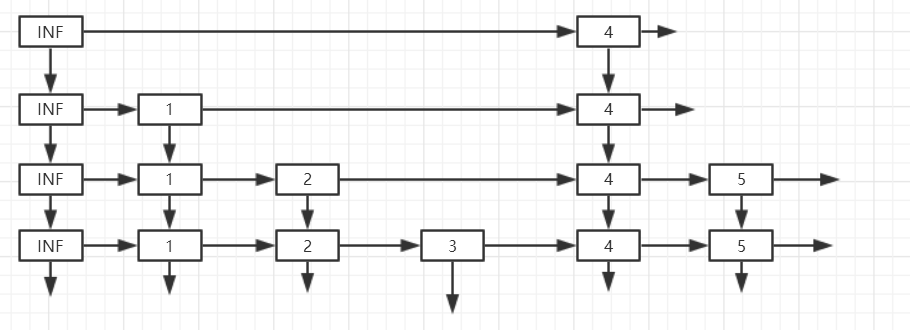java实现跳跃表
先贴上一个MIT跳跃表公开课链接:http://open.163.com/movie/2010/12/7/S/M6UTT5U0I_M6V2TTJ7S.html
redis中的有序链表结构就是在跳跃表的基础上实现的。详细的可以参考http://blog.csdn.net/acceptedxukai/article/details/17333673
我的实现方法是,最左侧使用数值的最小值(Double.MIN_VALUE)当作下界。因此,规定存储的值至少大于该值。
下面是跳跃表的图例

1,实现每个节点类
包含 分值score,val,以及next和down指针
/** * 跳跃表的节点的构成 * * @param <E> */ private static class SkipNode<E> { E val;//存储的数据 double score;//跳跃表按照这个分数值进行从小到大排序。 SkipNode<E> next, down;//next指针,指向下一层的指针 SkipNode() { } SkipNode(E val, double score) { this.val = val; this.score = score; } }
2,查找,插入,删除方法:即整个类的全部代码
package com.ljd.skiplist; import java.util.ArrayList; import java.util.List; import java.util.Random; /** * Created by author on 2017/10/9. * 实现跳跃表:能够对递增链表实现logN的查询时间 */ public class SkipList<T> { public static void main(String[] args) { //测试随机数生成的结果对二取模,结果是否是接近于0.5 // Random r = new Random(47); // int t = 1, a = 1; // while (a < 10000000) { // a++; // if (r.nextInt() % 2 == 0) // t++; // } // System.out.println(t * 1.0 / a); SkipList<String> list = new SkipList<>(); list.put(1.0, "1.0"); System.out.println(list); list.put(2.0, "2.0"); System.out.println(list); list.put(3.0, "3.0"); System.out.println(list); list.put(4.0, "4.0"); System.out.println(list); list.put(4.0, "5.0"); System.out.println(list); list.delete(3.0); list.delete(3.5); System.out.println(list); System.out.println("查找4.0" + list.get(4.0)); } /** * 跳跃表的节点的构成 * * @param <E> */ private static class SkipNode<E> { E val;//存储的数据 double score;//跳跃表按照这个分数值进行从小到大排序。 SkipNode<E> next, down;//next指针,指向下一层的指针 SkipNode() { } SkipNode(E val, double score) { this.val = val; this.score = score; } } private static final int MAX_LEVEL = 1 << 6; //跳跃表数据结构 private SkipNode<T> top; private int level = 0; //用于产生随机数的Random对象 private Random random = new Random(); public SkipList() { //创建默认初始高度的跳跃表 this(4); } //跳跃表的初始化 public SkipList(int level) { this.level = level; int i = level; SkipNode<T> temp = null; SkipNode<T> prev = null; while (i-- != 0) { temp = new SkipNode<T>(null, Double.MIN_VALUE); temp.down = prev; prev = temp; } top = temp;//头节点 } /** * 产生节点的高度。使用抛硬币 * * @return */ private int getRandomLevel() { int lev = 1; while (random.nextInt() % 2 == 0) lev++; return lev > MAX_LEVEL ? MAX_LEVEL : lev; } /** * 查找跳跃表中的一个值 * * @param score * @return */ public T get(double score) { SkipNode<T> t = top; while (t != null) { if (t.score == score) return t.val; if (t.next == null) { if (t.down != null) { t = t.down; continue; } else return null; } if (t.next.score > score) { t = t.down; } else t = t.next; } return null; } public void put(double score, T val) { //1,找到需要插入的位置 SkipNode<T> t = top, cur = null;//若cur不为空,表示当前score值的节点存在 List<SkipNode<T>> path = new ArrayList<>();//记录每一层当前节点的前驱节点 while (t != null) { if (t.score == score) { cur = t; break;//表示存在该值的点,表示需要更新该节点 } if (t.next == null) { path.add(t);//需要向下查找,先记录该节点 if (t.down != null) { t = t.down; continue; } else { break; } } if (t.next.score > score) { path.add(t);//需要向下查找,先记录该节点 if (t.down == null) { break; } t = t.down; } else t = t.next; } if (cur != null) { while (cur != null) { cur.val = val; cur = cur.down; } } else {//当前表中不存在score值的节点,需要从下到上插入 int lev = getRandomLevel(); if (lev > level) {//需要更新top这一列的节点数量,同时需要在path中增加这些新的首节点 SkipNode<T> temp = null; SkipNode<T> prev = top;//前驱节点现在是top了 while (level++ != lev) { temp = new SkipNode<T>(null, Double.MIN_VALUE); path.add(0, temp);//加到path的首部 temp.down = prev; prev = temp; } top = temp;//头节点 level = lev;//level长度增加到新的长度 } //从后向前遍历path中的每一个节点,在其后面增加一个新的节点 SkipNode<T> downTemp = null, temp = null, prev = null; // System.out.println("当前深度为"+level+",当前path长度为"+path.size()); for (int i = level - 1; i >= level - lev; i--) { temp = new SkipNode<T>(val, score); prev = path.get(i); temp.next = prev.next; prev.next = temp; temp.down = downTemp; downTemp = temp; } } } /** * 根据score的值来删除节点。 * * @param score */ public void delete(double score) { //1,查找到节点列的第一个节点的前驱 SkipNode<T> t = top; while (t != null) { if (t.next == null) { t = t.down; continue; } if (t.next.score == score) {
// 在这里说明找到了该删除的节点
t.next = t.next.next;
t = t.down;
//删除当前节点后,还需要继续查找之后需要删除的节点
continue;
} if (t.next.score > score) t = t.down; else t = t.next; } } @Override public String toString() { StringBuilder sb = new StringBuilder(); SkipNode<T> t = top, next = null; while (t != null) { next = t; while (next != null) { sb.append(next.score + " "); next = next.next; } sb.append("\n"); t = t.down; } return sb.toString(); } }
对于插入的时候,在寻找插入位置的同时,我使用了一个ArrayList存储查找方向向下时的节点。这样在构造节点的时候,只需要直接从这个list中拿prev节点就行了。
下面这种方式的实现,比上面的少消耗了很多存val的空间,这个后续看能否实现。



